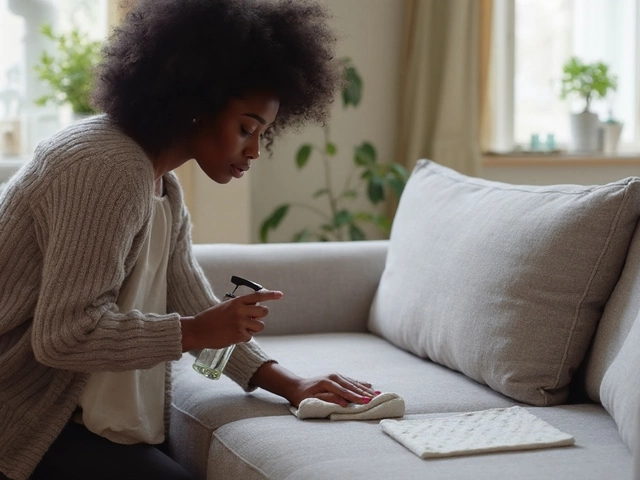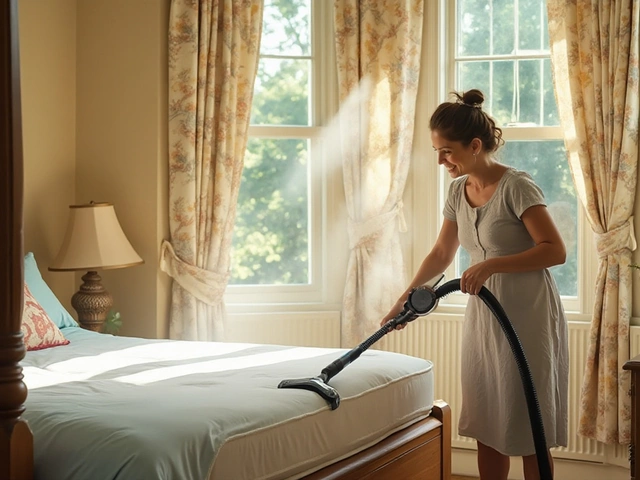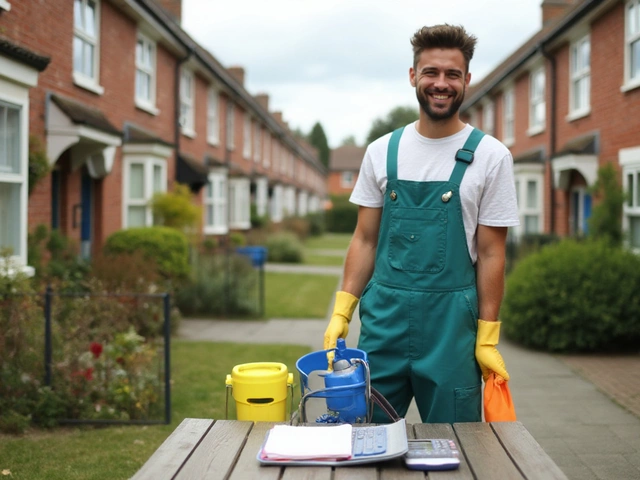Ever find yourself wondering how professional detailers keep upholstery so spotless? It's not magic—it's a mix of the right tools, products, and techniques. They're working smarter, not harder. Let's unpack their secrets, so you can bring that same shine to your own living space or car interior.
Detailers often rely on specialized tools. One of their favorite gadgets is the steam cleaner. This little device is great at lifting dirt and grime without leaving any harsh chemical residues. And for those tricky, tight spots, a good handheld brush or fabric drill brush can be a game-changer. These tools help ensure every inch is as clean as the big, visible spots.
Now, let's talk products. Detailers don't just grab any old cleaner off the shelf. They opt for products tailored to the job, like pH-balanced solutions that won't damage fabric fibers. Many professionals prefer eco-friendly or enzymatic cleaners, which are tough on stains but gentle on the environment and your health.
- Specialized Tools for the Job
- Effective Cleaning Products
- Steam Cleaning: Magic with Heat
- Natural Solutions for Sensitive Fabrics
- DIY Tips and Tricks from the Pros
Specialized Tools for the Job
When it comes to achieving that spotless finish, detailers don't just rely on elbow grease. They've got a secret arsenal of tools to make upholstery look brand new. Let's peek into their toolbox.
Steam Cleaners
Steam cleaners are a detailer’s best friend. These machines use hot steam to lift dirt effortlessly, making them perfect for upholstery cleaning. They're effective without the need for harsh chemicals, making them a safe choice for families and pets. The steam not only cleans but also sanitizes, killing off bacteria hiding in those fibers.
Fabric Drill Brushes
For those stubborn spots, especially in high traffic areas, detailers might employ a fabric drill brush. These attach to a regular drill and provide the rotational force needed to break up tough stains without damaging the fabric. It's like giving your vacuum cleaner a superpower!
Handheld Brushes
Not all nooks and crannies can be reached with big tools, which is why handheld brushes are essential. They let detailers get into the tight spots, like between car seats or under couch cushions, where crumbs and dust settle.
Vacuum with Attachments
No detailer's toolkit is complete without a good vacuum. But it's the attachments that make all the difference. Crevice tools get into the narrow gaps, while upholstery nozzles are designed to pull dirt out of fabric without sucking it in.
Microfiber Cloths
Last but not least, the humble microfiber cloth. These are used for wiping down surfaces after cleaning. They're gentle on fabrics and pick up leftover moisture and dirt particles that other tools might miss.
By using this lineup of detailing tools, professionals ensure they’re not just cleaning, but doing it efficiently. So next time you see spotless, fresh-smelling upholstery, you'll know it's all thanks to the right tools doing the heavy lifting.
Effective Cleaning Products
When it comes to upholstery cleaning, using the right products is half the battle. Detailers know this well and have a few go-to solutions that get the job done, sans the hassle.
pH-Balanced Cleaners
First off, let's talk about pH-balanced cleaners. These are the unsung heroes in the world of detailing. They are formulated to be gentle on fabrics, ensuring that the fibers aren't damaged during the cleaning process. When shopping, look for something labeled as pH neutral, especially if you're tackling sensitive or natural fabrics like wool or cotton.
Enzymatic Cleaners
Enzymatic cleaners are another favorite among the pros. They work by breaking down organic matter—think food spills or pet accidents—thanks to the active enzymes present in the solution. It's like having tiny pac-men munching away on the gunk. They’re especially handy when dealing with stubborn organic stains. Just spray, let it sit, and wipe away.
Eco-friendly Options
Don't forget the eco-friendly options. These are not only gentle on your upholstery but also environmentally responsible. Brands offering such products often use natural ingredients that are biodegradable, ensuring both your health and planet are cared for. Look for ingredients like plant-based oils and natural fragrance.
Product Preferences
For those who prefer ready-to-use products, the market is flooded with options. Some well-rated brands include SpotClean’s fabric cleaner and Naturama’s plant-based sprays. Many also swear by homemade mixtures for a quick fix using household items like vinegar and baking soda, but it's key to spot-test these first.
| Product Type | Common Uses | Application Tip |
|---|---|---|
| pH-Balanced Cleaner | General fabric cleaning | Always spot test |
| Enzymatic Cleaner | Organic stain removal | Let sit for optimal effect |
| Eco-friendly Cleaner | Sensitive materials | Avoid heavy fragrances |
With these products at your disposal, keeping your upholstery squeaky clean just got a little easier. The key is to pair the right product with the right type of dirt or stain, and you're golden.
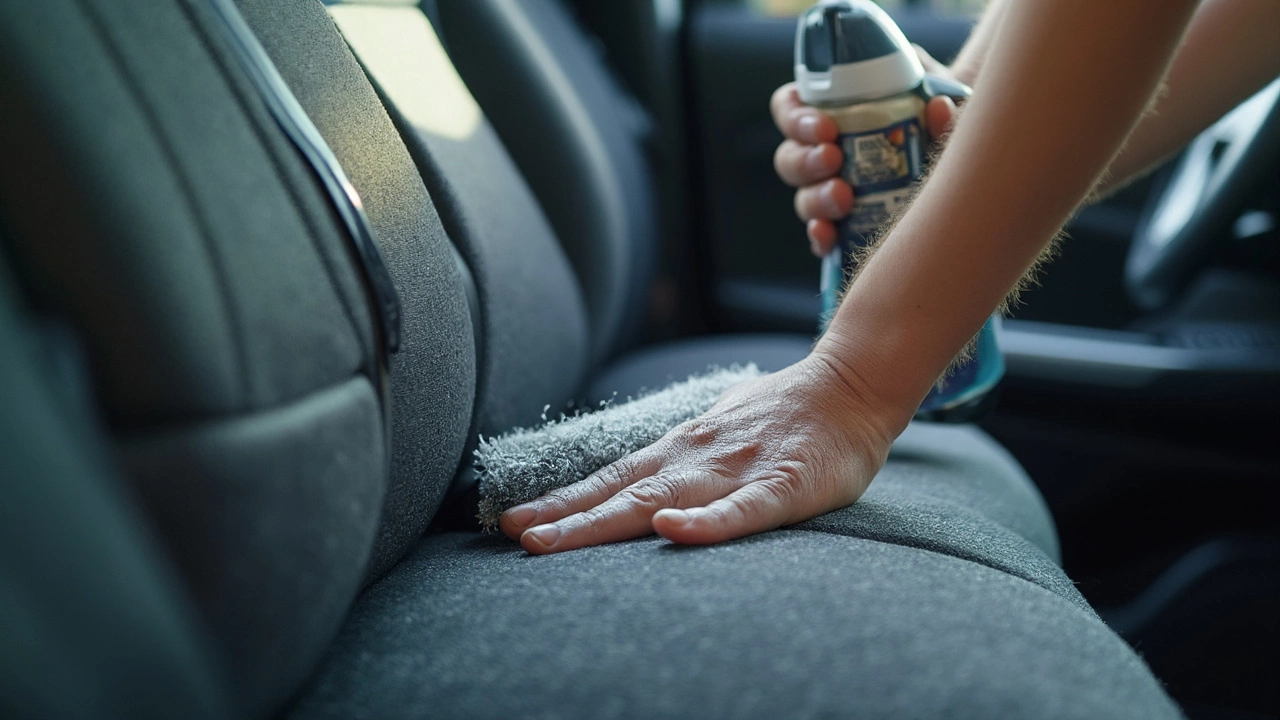
Steam Cleaning: Magic with Heat
When it comes to cleaning upholstery, steam cleaning often feels like a go-to choice for detailers—and for good reason! Steam works wonders because it uses heat to lift dirt and grime, sanitizing surfaces without the need for harsh chemicals. This isn't just a surface clean; it's deep-down and thorough.
Why is steam so effective? Firstly, it reaches temperatures high enough (usually between 150 to 300 degrees Fahrenheit) to dissolve dirt and kill bacteria, dust mites, and other allergens. This makes it not only a cleaning tool but a health booster too.
How Does It Work?
Steam cleaners produce a fine vapor that penetrates even the tightest of fabric weaves. The heat breaks down the bonds holding dirt and stains, allowing them to be wiped away easily. Here's a simple breakdown of the process:
- Fill the steam cleaner with water.
- Heat the water to produce steam.
- Direct the steam onto the upholstered area.
- Gently rub the area with a towel or microfiber cloth to lift the loosened dirt.
The best part? It's chemical-free, meaning it's kind to the planet and your home environment.
The Professional Edge
"Steam cleaning is a game-changer for upholstery. It offers a level of sanitation that's hard to match," says Jamie Stevens, author of 'The Clean Home Handbook'.
Another bonus is that steam cleaning tends to be safe for most fabrics, but it’s always smart to do a spot test first. Detailers will often use it for car interiors, soft furniture, and even carpets, highlighting its versatility.
Stats that Count
| Feature | Benefit |
|---|---|
| Temperature | 150-300°F |
| Time to Heat | Approximately 3-5 minutes |
| Water Usage | 1 gallon per hour |
With these facts in mind, it's clear why detailers choose steam cleaning as a staple in their toolkits. It's efficient, eco-friendly, and thoroughly effective—making it a top choice for anyone looking to maintain their upholstery in prime condition.
Natural Solutions for Sensitive Fabrics
When it comes to cleaning upholstery, sensitive fabrics need a bit of extra TLC to avoid damage. Thankfully, there are natural methods that are both effective and gentle. These are perfect if you’re looking to keep things eco-friendly or if you're worried about harsh chemicals harming your precious fabrics.
Vinegar and Baking Soda Combo
Vinegar and baking soda are a dynamic duo in the world of cleaning. For upholstery, they can work miracles on light stains and odors. Start by sprinkling a bit of baking soda on the fabric. Let it sit for about 10 to 15 minutes to absorb odors and moisture. Then, vacuum it up. Next, mix a solution of equal parts water and white vinegar in a spray bottle. Lightly spritz it onto the fabric and let it dry. The vinegar scent will fade as it helps kill bacteria.
Lemon Juice and Oil for Freshness
Did you know you can use lemon juice to freshen up upholstery? Mix one cup of lukewarm water with a tablespoon of lemon juice in a spray bottle. For added freshness, consider adding a drop of essential oil like lavender. Lightly mist your upholstery, ensuring not to saturate the fabric. This mix helps break down grime and leaves a refreshing scent.
Cornstarch for Grease Stains
For pesky grease stains, cornstarch can be your best friend. Sprinkle it directly onto the stain and let it sit for at least 10 minutes to absorb the oil. Then, gently brush it off and vacuum. It’s a simple trick that tackles grease without any hassle.
These natural solutions provide an excellent alternative for maintaining upholstery without resorting to harsh chemicals. Were you aware that around 60% of people prefer to try DIY cleaning techniques at home? It’s all about finding what works best for your fabric while keeping it kind to the environment. Give these tips a try and keep your furniture looking its best naturally!
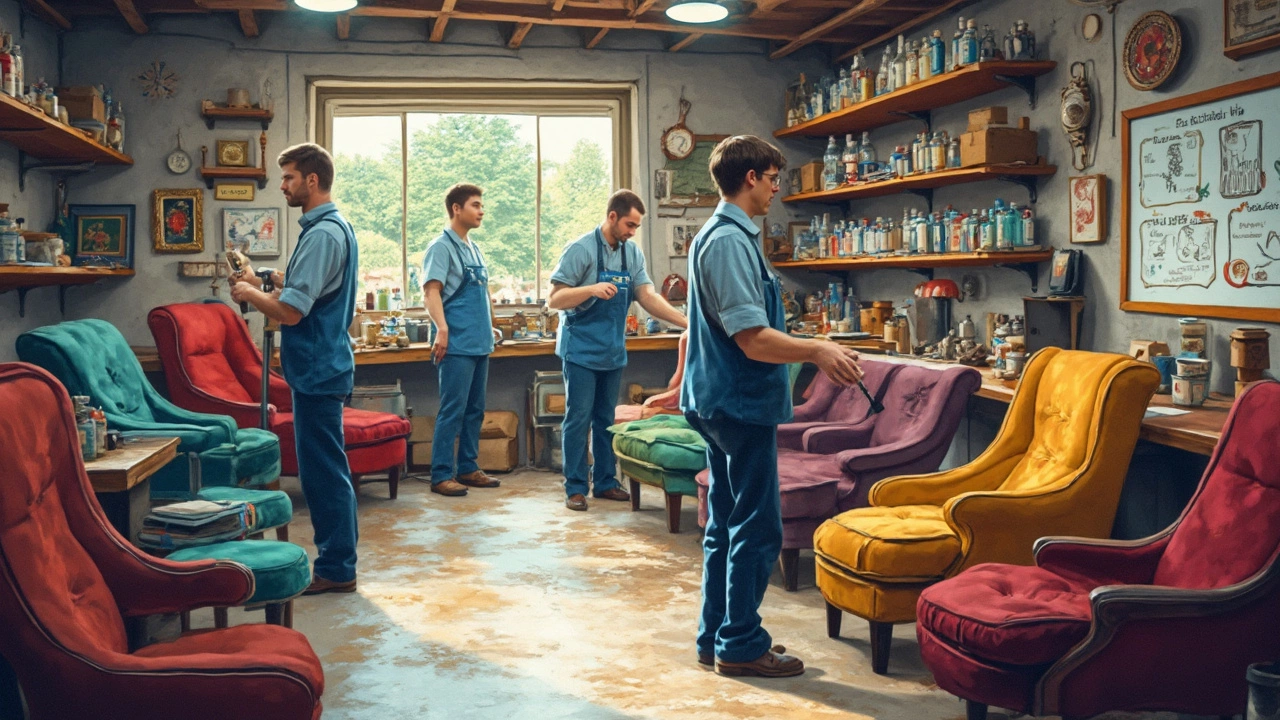
DIY Tips and Tricks from the Pros
Thinking about tackling upholstery cleaning on your own? Well, you're in luck because I've got some awesome tips straight from the pros. Whether you're freshening up your car seats or home furniture, these tricks will have you cleaning like a detailer in no time!
Pre-Treat Stains
Before diving in with the cleaning, it's crucial to pre-treat any noticeable stains. Mix up a simple solution of water and mild dish soap. Dab it onto the stain with a microfiber cloth and let it sit for about 10 minutes. This helps lift the stain, making it easier to tackle later.
Tackle the Dust
Start with a good vacuum session. Use your vacuum's upholstery attachment to suck up dust and loose dirt from all the nooks and crannies. A regular vacuum can help maintain your upholstery and make the deep cleaning process much more effective.
Homemade Cleaning Solution
Rather than heading to the store, consider making your own cleaner. Combine equal parts white vinegar and warm water in a spray bottle. Lightly mist the fabric, then gently scrub with a soft brush. White vinegar is a great deodorizer and cuts through grime!
Steam to the Rescue
If you've got access to a little steam cleaner, use it! Steam cleaning is popular in detailing services for a reason. It sanitizes and refreshes fabric without chemicals. Just be sure your upholstery can handle the heat before you begin.
Drying Out
After cleaning, avoid sitting on the upholstery until it's fully dry. Speed up the process with a small fan or open windows for better air circulation. This prevents mold and gives the upholstery a nice, fresh feel.
| Upholstery Cleaning Tips | Average Time Spent |
|---|---|
| Pre-Treat Stains | 10 minutes |
| Vacuum Upholstery | 15 minutes |
| Apply Homemade Solution | 20 minutes |
| Steam Cleaning | 30 minutes |
So, there you have it. Just a few simple steps and your upholstery will look professionally detailed at a fraction of the cost. And the best part? You probably have many of these tools and products lying around at home already. Ready to get cleaning? Go for it!
